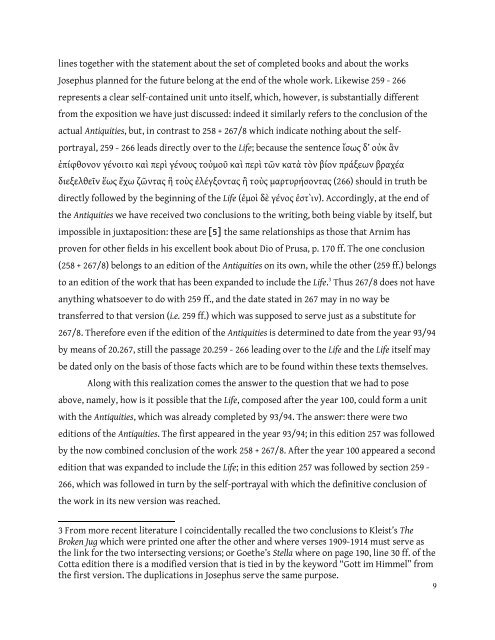The Jewish Historian Flavius Josephus: A Biographical Investigation
The Jewish Historian Flavius Josephus: A Biographical Investigation
The Jewish Historian Flavius Josephus: A Biographical Investigation
Create successful ePaper yourself
Turn your PDF publications into a flip-book with our unique Google optimized e-Paper software.
lines together with the statement about the set of completed books and about the works<br />
<strong>Josephus</strong> planned for the future belong at the end of the whole work. Likewise 259 - 266<br />
represents a clear self-contained unit unto itself, which, however, is substantially different<br />
from the exposition we have just discussed: indeed it similarly refers to the conclusion of the<br />
actual Antiquities, but, in contrast to 258 + 267/8 which indicate nothing about the selfportrayal,<br />
259 - 266 leads directly over to the Life; because the sentence ἴσως δ’ οὐκ ἂν<br />
ἐπίφθονον γένοιτο καὶ περὶ γένους τοὐμοῦ καὶ περὶ τῶν κατὰ τὸν βίον πράξεων βραχέα<br />
διεξελθεῖν ἕως ἔχω ζῶντας ἢ τοὺς ἐλέγξοντας ἢ τοὺς μαρτυρήσοντας (266) should in truth be<br />
directly followed by the beginning of the Life (ἐμοὶ δὲ γένος ἐστ`ιν). Accordingly, at the end of<br />
the Antiquities we have received two conclusions to the writing, both being viable by itself, but<br />
impossible in juxtaposition: these are [5] the same relationships as those that Arnim has<br />
proven for other fields in his excellent book about Dio of Prusa, p. 170 ff. <strong>The</strong> one conclusion<br />
(258 + 267/8) belongs to an edition of the Antiquities on its own, while the other (259 ff.) belongs<br />
to an edition of the work that has been expanded to include the Life. 3 Thus 267/8 does not have<br />
anything whatsoever to do with 259 ff., and the date stated in 267 may in no way be<br />
transferred to that version (i.e. 259 ff.) which was supposed to serve just as a substitute for<br />
267/8. <strong>The</strong>refore even if the edition of the Antiquities is determined to date from the year 93/94<br />
by means of 20.267, still the passage 20.259 - 266 leading over to the Life and the Life itself may<br />
be dated only on the basis of those facts which are to be found within these texts themselves.<br />
Along with this realization comes the answer to the question that we had to pose<br />
above, namely, how is it possible that the Life, composed after the year 100, could form a unit<br />
with the Antiquities, which was already completed by 93/94. <strong>The</strong> answer: there were two<br />
editions of the Antiquities. <strong>The</strong> first appeared in the year 93/94; in this edition 257 was followed<br />
by the now combined conclusion of the work 258 + 267/8. After the year 100 appeared a second<br />
edition that was expanded to include the Life; in this edition 257 was followed by section 259 -<br />
266, which was followed in turn by the self-portrayal with which the definitive conclusion of<br />
the work in its new version was reached.<br />
3 From more recent literature I coincidentally recalled the two conclusions to Kleist’s <strong>The</strong><br />
Broken Jug which were printed one after the other and where verses 1909-1914 must serve as<br />
the link for the two intersecting versions; or Goethe’s Stella where on page 190, line 30 ff. of the<br />
Cotta edition there is a modified version that is tied in by the keyword “Gott im Himmel” from<br />
the first version. <strong>The</strong> duplications in <strong>Josephus</strong> serve the same purpose.<br />
9
















